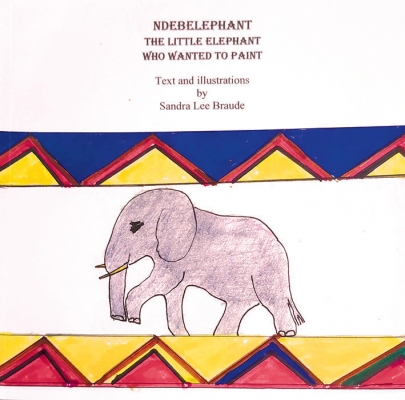Ndebelephant: The Little Elephant Who Wanted to Paint
Text and illustrations by Sandra Lee Braude
Reviewed by Judy Shapiro
The women of the Ndebele tribe, which is situated in the Northern section South Africa, paint murals on their huts in beautiful colors. They have been doing this for generations and their paintings are considered to be great works of art.
One old Ndebele woman, whose children had left to build their own lives, sits beside her simple, unadorned hut, wishing that someone could help her make her house beautiful. Far away, a little elephant wants to paint, but no-one will let him. He would paint anything, given the chance—even the clouds. Any adult reading this book to a child is certain that by the end of the story, the elephant will help the woman paint her house. The quandary is how are the two going to find each other.
There are many children's stories written of a young animal trying to find a place to live. A chick, bunny, mouse or kitten asks different animals if they could live with them, but are refused and discouraged until they find either their own kind or a satisfactory replacement where they can live.
In this story, the baby elephant is misunderstood and unappreciated by his parents, his friends, a lion and a snake. He feels unloved. His mother wants him to take a mud-bath. His father wants him to strip bark from trees. His friends want him to join their game. The lion and snake don't want him near them. Eventually, wandering around, he finds the old woman who gives him food to eat and an opportunity to paint her house. The result is so beautiful that he ends up receiving compliments from his parents, friends and "people from everywhere". He now feels loved. He continues to paint Ndebele huts, earns the name Ndebelephant, receives a medal and becomes famous. He is happy and the woman is happy. Our young reader is happy because it's an interesting story, simply told, sweetly illustrated and to which he can relate. A drawing of a hut is left for the child to color.
But within the lines of this story are another stories and lessons to be learned, not only for children, but for adults as well. The little elephant is polite, but stubborn. He wants to paint, but he will not do what his elders and friends ask him to do. He has an answer for everything.
He doesn't wasn't a mud-bath because he doesn't want to get dirty. He won't strip barks from trees because he doesn't want to ruin the trees. His teacher wants him to learn to trumpet with his trunk but he says it will frighten the birds. His friends invite him to join tails and walk in a circle, but he says it makes him dizzy. In short, he refuses to act like an elephant, even if there is a good reason to do so. A mud-bath will cool him down, provide a protective layer to shield his body from the sun's rays and relieve him from insect bites. Stripping bark from trees allows him to get nutrients and stored water. Trumping frightens adversaries. Joining his trunk with the tail of the elephant before him protects him. This is not explained to him or to the reader. The elephant says that he just wants to paint. He refuses to do anything else.
The mother says, "You are a naughty elephant, and you will go to bed without supper." The father says, "You are a lazy elephant and cannot come into the forest with me anymore." The teacher says he is talking nonsense and that he is "…just a stupid little elephant." His friends call him "…weird." There is a serious lack of communication here. Not only are no explanations given to the elephant; his parents and peers sting him with hurtful responses. There is no attempt to understand him or to offer a compromise.
The little elephant perseveres. He will paint. And at the end, he does, and receives accolades from the other elephants. What he doesn't learn, however, is that he was also wrong. Not only was he wrong, but he put himself in danger. Leaving the herd and confronting a lion and a snake is serious business. He could have been killed. Male lions can kill African elephants and the venom of a King Cobra's bite to the trunk of an elephant can kill him as well.
If we are to educate our children, we must teach them about safety. They must learn responsibility, good habits, compromise and respect. And they should listen to their parents who are more often wiser and have had more experience. That said, we nevertheless find children who appreciate their parents' advice only after they have gone their own way and achieved recognition. Having been accepted, appreciated and loved both by society and their families, and hopefully having matured, they can acknowledge the wisdom of their elders. We can only presume that only after achieving recognition of his talents, our little elephant will take mud baths, strip bark off trees, learn to trumpet and circle with his friends.
This story advises parents to appreciate and encourage the perseverance and dreams of their children. Perhaps, most of all, the symbiotic relationship between the old Ndebele woman and the young elephant reminds all of us of the beautiful connection which can and should be fostered between the old and the young.
Sandra Lee Braude
301 Protea Hills
Moshav Shoresh, Mobile Post Harel Yehuda, 908000, Israel
Tel: +927 077 8655301
Mob: +972 052 790 1522
This email address is being protected from spambots. You need JavaScript enabled to view it.
Herstoria Press 2019
35 pages
50 shekels (free postage)









Comments